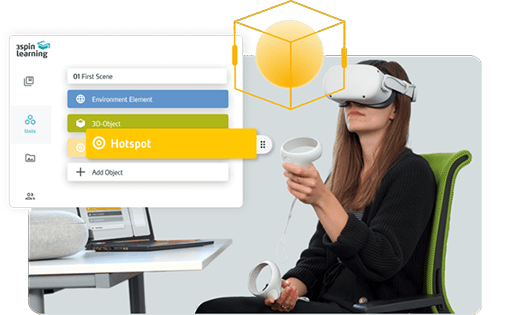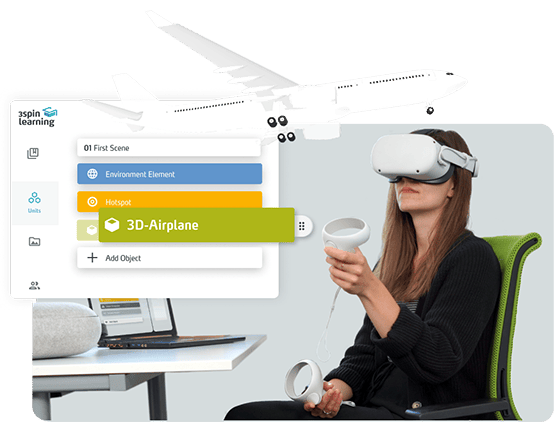LMS Benefits for Using VR & AR Technology
Learn about LMS Benefits and how authoring platforms such as 3spin Learning can help you smoothly integrate Virtual and Augmented Reality into your...
Discover whether VR learning or traditional learning is better suited for the development of your employees.
As traditional learning methods have long served as the default, the potential of virtual communication in the field of human resource development should be explored. A side-by-side comparison of the advantages and disadvantages of both approaches will shed light on which method is more promising for improving the skills and knowledge of the modern workforce.
Traditional learning, characterized by physical classrooms, textbooks, and face-to-face interaction, has been the basis of education for centuries. There are several advantages to this approach, such as direct communication between teachers and students, the ability to ask questions in real-time, and immediate feedback. Traditional learning fosters a sense of community, collaboration, and social interaction among learners. However, traditional learning also has its limitations. One major drawback is its lack of flexibility.
On the other hand, a virtual classroom provides an immersive and interactive learning experience that simulates real-world scenarios. This allows learners to engage with virtual environments, manipulate objects, and practice skills in a risk-free environment.
This technology can be particularly valuable for workforce development as it allows employees to gain hands-on experience without the associated costs and potential dangers of real-world training. VR learning also offers the flexibility to learn at one's own pace and allows access to a wide range of educational content regardless of location.
One of the main benefits of virtual learning is improved memory and engagement.
Studies have shown that learners who engage in VR experiences retain knowledge better compared to traditional methods.
The immersive nature of VR captures learners' attention and makes the learning process more enjoyable and memorable. In addition, VR can create a sense of presence, allowing learners to develop skills and memories as if they were in a real environment.
Another strength of VR learning lies in its potential to replicate complex and dangerous situations. In industries where safety is paramount, such as healthcare or manufacturing, VR simulations can provide employees with realistic training experiences that prepare them for challenging scenarios. By practicing in a virtual environment, learners develop the confidence and expertise to handle critical situations without endangering themselves or others.

When considering the question of which approach is better for workforce development, it is crucial to recognize that there is no one-size-fits-all answer. Both traditional learning and VR learning have unique strengths and weaknesses.
The optimal approach may depend on various factors, including the specific learning objectives, the nature of the industry, the target audience, and available resources.
Traditional learning scores highly thanks to direct social interaction, proven pedagogical methods and the use of established infrastructures. It is a familiar and accessible form of learning for many target groups.
Immersive learning with VR and AI, on the other hand, opens up new possibilities: Content is not only better understood through realistic simulations, but also more sustainably anchored. Users train in safe, interactive environments. Training courses can be individually adapted and scaled without any loss of quality.
The decision on the right format ultimately depends on the specific learning objectives, the target group and the available resources. Although VR technology initially requires investment in hardware, it offers a superior learning experience with demonstrably higher practical transfer.
For all its benefits, the adoption of VR technology can be expensive, as VR glasses and other hardware are required, limiting access for some organizations or individuals.
In contrast, traditional learning is often tied to time, place, and deadlines, making it difficult for learners to balance work, personal commitments, and education. Similarly, traditional learning methods do not always provide optimal knowledge retention due to passive learning approaches and limited engagement.
The effectiveness of VR training or traditional learning can vary depending on the context, topic, and individual learner preferences. Both approaches have their strengths and weaknesses, and the ideal approach may differ depending on the specific learning objectives and available resources.
VR learning offers eLearning authors a powerful tool to create immersive and engaging educational experiences. Here's an overview of how VR learning works for eLearning authors:
eLearning authors begin by defining the learning objectives and outcomes they want to achieve through VR learning. This helps in structuring the content and activities within the virtual environment.
eLearning authors work on developing the virtual environment and creating content that aligns with the learning objectives. This involves designing 3D models, textures, and environments that accurately represent the desired scenario or workplace. They also develop interactive elements, such as objects, tools, or simulations, that learners can interact with in the virtual environment.
eLearning authors choose a VR learning platform or software that suits their requirements. There are various VR platforms available, both commercial and open-source, offering different features and capabilities. The chosen platform should support content creation, interaction design, and integration with VR headsets and controllers.
Content Creators design the interactions and activities that learners will engage in within the virtual environment. They determine how learners will interact with objects, perform actions, and solve problems. This involves mapping controls to the VR hardware, defining the mechanics of interactions, and ensuring intuitive and user-friendly interfaces.
Depending on the chosen VR platform, eLearning authors may need to script or program certain features within the virtual environment. This could include scripting interactions, creating triggers for feedback and assessments, or implementing branching scenarios based on learners' actions.
VR Content Creators incorporate feedback and assessment mechanisms within the VR learning experience. This can involve providing real-time feedback to learners based on their interactions or decision-making, evaluating their performance against predefined criteria, or integrating quizzes or assessments within the virtual environment.
eLearning authors conduct thorough testing of the VR learning experience to ensure its functionality, usability, and alignment with the learning objectives. They gather feedback from learners or subject matter experts and make necessary iterations and improvements based on the feedback received.
Once the VR learning experience is developed and tested, eLearning authors deploy and deliver it to the target audience. This may involve deploying the VR content on specific VR headsets or through VR-enabled applications or platforms. eLearning authors may also provide instructions or guidance on how to navigate and interact within the virtual environment.
Creators use analytics and data tracking tools to gather information about learners' interactions and performance within the VR learning experience. This data can help in evaluating the effectiveness of the VR learning module, identifying areas for improvement, and making data-driven decisions for future iterations or updates.
By leveraging VR technology, eLearning authors can create immersive and memorable learning experiences that go beyond traditional eLearning methods. VR learning allows them to engage learners in realistic scenarios, enhance knowledge retention, and provide hands-on practice in a safe and controlled environment.
In conclusion, while traditional learning has been the cornerstone of education for centuries, VR learning has emerged as a transformative tool for workforce development.
VR learning offers unparalleled immersion, engagement, and the ability to replicate real-world scenarios, providing learners with valuable experiences and enhancing their skills.

Learn about LMS Benefits and how authoring platforms such as 3spin Learning can help you smoothly integrate Virtual and Augmented Reality into your...
Improve your students' online learning experiences with our guide to choosing the right virtual classroom software.
Looking to maximize your training potential? Discover how VR training provides a safe, engaging, and effective learning experience
Stay up to date on new insights in VR / AR learning with AI and build or improve your knowledge within the technology.